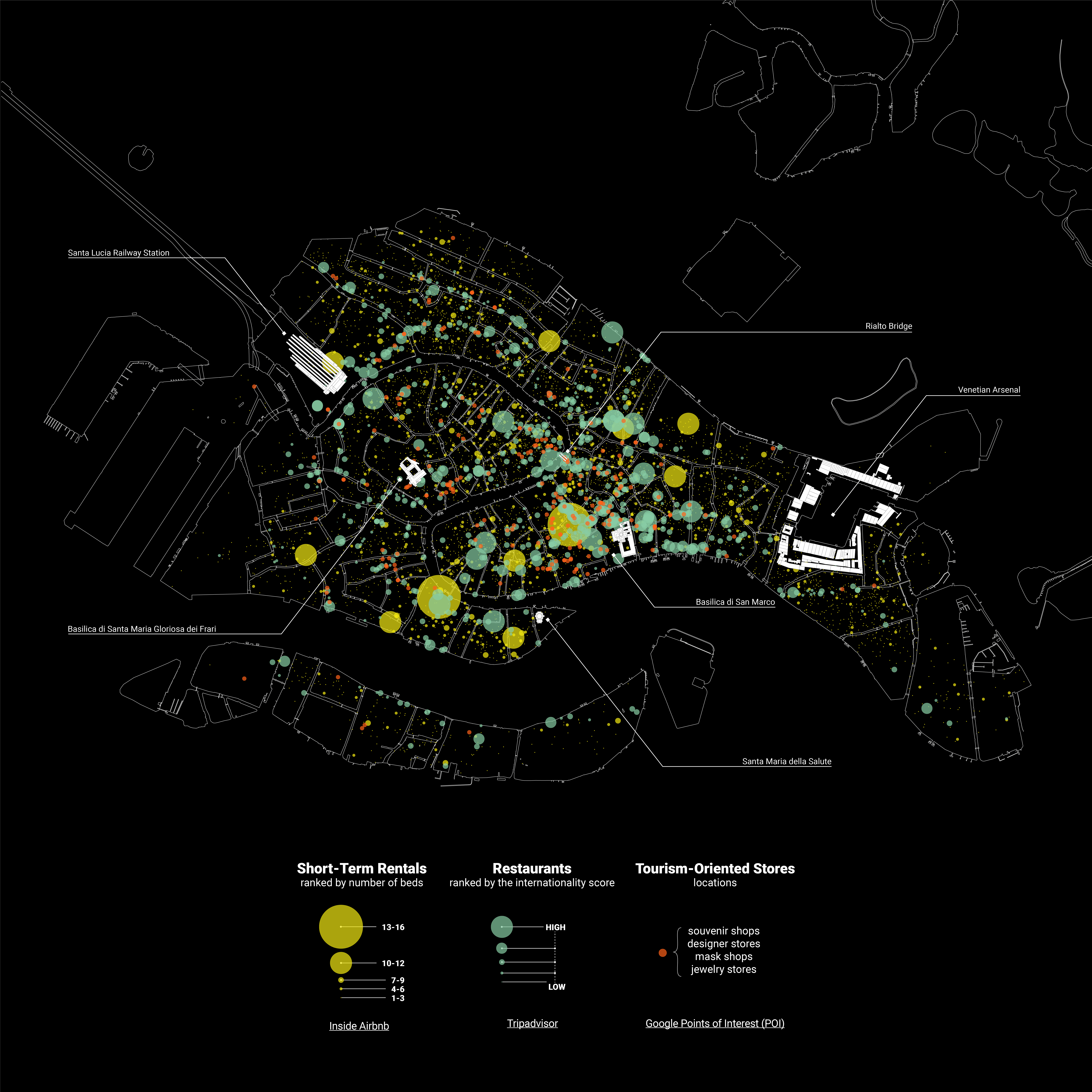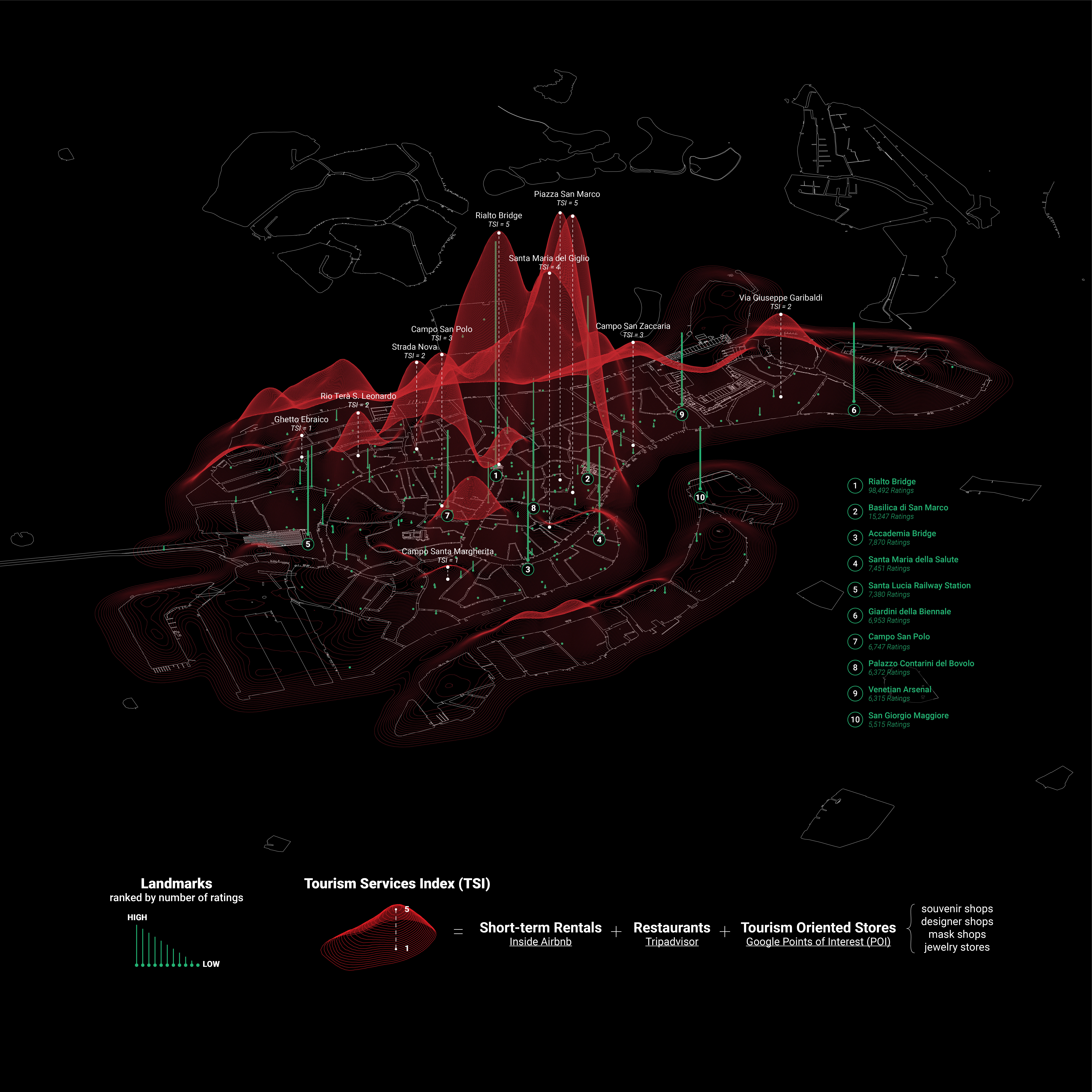




Media Coverage
︎︎︎ MIT News - 08.18.2023 - “MIT at the 2023 Venice Biennale ” by M. Iacobo
︎︎︎ Arkitera [TK] - 05.31.2023 - “Rethinking Urban Tourism in Venice Through Big Data” by E. Merdim
︎︎︎ LiveSicilia [IT] - 05.27.2023 - “Catania, la mostra di Carmelo Ignaccolo dagli States alla Biennale di Venezia” by Giulia Costanzo
︎︎︎ MIT SA+P Medium - 05.24.2023 - “The Consumed City”
︎︎︎ MIT DUSP News - 05.20.2023 - “The Consumed City: an exhibition in Venice” by T. Kuwabara
︎︎︎ Area [IT] - 05.12.2023 - “THE CONSUMED CITY a Palazzo Mora, Venezia” by A. Benelli
︎︎︎ Arts at MIT - 04.28.2023 - “Council for the Arts at MIT Spring 2023 Grant Recipients” by L. Brosnahan
Publications
︎︎︎ Ignaccolo C. (2023). “The Consumed City” (pp. 192-193). In European Cultural Centre (Ed.) Time Space Existence. ECC, Venice (ITA) - ISBN 9789082943474
︎︎︎ MIT News - 08.18.2023 - “MIT at the 2023 Venice Biennale ” by M. Iacobo
︎︎︎ Arkitera [TK] - 05.31.2023 - “Rethinking Urban Tourism in Venice Through Big Data” by E. Merdim
︎︎︎ LiveSicilia [IT] - 05.27.2023 - “Catania, la mostra di Carmelo Ignaccolo dagli States alla Biennale di Venezia” by Giulia Costanzo
︎︎︎ MIT SA+P Medium - 05.24.2023 - “The Consumed City”
︎︎︎ MIT DUSP News - 05.20.2023 - “The Consumed City: an exhibition in Venice” by T. Kuwabara
︎︎︎ Area [IT] - 05.12.2023 - “THE CONSUMED CITY a Palazzo Mora, Venezia” by A. Benelli
︎︎︎ Arts at MIT - 04.28.2023 - “Council for the Arts at MIT Spring 2023 Grant Recipients” by L. Brosnahan
Publications
︎︎︎ Ignaccolo C. (2023). “The Consumed City” (pp. 192-193). In European Cultural Centre (Ed.) Time Space Existence. ECC, Venice (ITA) - ISBN 9789082943474
The Consumed City
Once the heart of a powerful maritime republic, Venice’s historic city has lost more than 120,000 residents since the early 1950s, driven away by myriad issues, including, more recently, 21st-century mass tourism. These intertwined socio-economic dynamics have put the city of Venice into an existential conundrum: can Venice be both a tourist attraction and a nice place to live?
Through maps and animated visualizations, The Consumed City–an exhibition by MIT researcher Carmelo Ignaccolo currently on view at Palazzo Mora (European Cultural Centre) during the 2023 Venice Architecture Biennale–narrates a spatial investigation of tourism in Venice by harnessing data on lodging (6,642 Airbnb listings, InsideAirbnb), dining (997 restaurants, Tripadvisor), and shopping (226 tourist-oriented stores, Google Points of Interest).
The Consumed City invites visitors to experience and understand the omnipresence of tourism in Venice through the lenses of big data and digital visualizations. Visitors are encouraged to explore the geography of Venice and the distribution of Airbnbs (some of them with more than 15 beds in a single apartment unit!), restaurants ranked by an ad hoc Internationality Score (calculated by mining thousands of Tripadvisor reviews in more than 20 languages), and tourist-oriented stores. By showcasing the complexity of tourism dynamics, the maps of The Consumed City render visible the tourism geography of the city. Moreover, they become instrumental in raising awareness about the urgent need to construct a more socio-economic resilient Venice.
In conclusion, The Consumed City acts as a visual policy-making tool to advocate for the use of maps and data analytics to support tourism management strategies in cities “consumed” by overtourism.
Sponsors
The “Consumed City” is sponsored by the Council for the Arts at MIT and by the MIT Urban Planning Department’s Bemis Fund, generously provided by Dean Hashim Sarkis of the MIT School of Architecture and Planning and Curator of the Venice Architecture Biennale 2021). “The Consumed City“ was further supported by the Minda de Gunzburg Center for European Studies at Harvard University.
Exhibition Team
Artist and Curator: Carmelo Ignaccolo
Scientific Supervision: Prof. Sarah Williams
Researchers: Emily Levenson, Melody Phu, Leo Saenger, Yuke Zheng
Digital Animation Designer: Ting Zhang
Exhibition Design Assistant: Dila Ozberkman
Scientific Supervision: Prof. Sarah Williams
Researchers: Emily Levenson, Melody Phu, Leo Saenger, Yuke Zheng
Digital Animation Designer: Ting Zhang
Exhibition Design Assistant: Dila Ozberkman